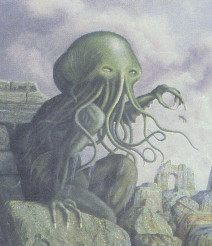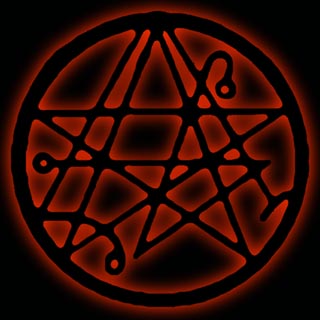and Necronomicon
Mythos Creation
That is not dead which can eternal lie,
And with strange aeons even death may die.
-Necronomicon
[Search for Necronomicons on eBay]
You've probably found this page out of a desire to learn about the Necronomicon, or Cthulhu, or ancient tomes and spellbooks. Well, you've come to the wrong place... or have you? You may find something for which you didn't know you were seeking. You may find answers you never wanted or needed, or may just find yourself. The knowledge presented here does not come without a cost. The cost of course is the time you will waste reading it, but that's another issue altogether. A great deal of fun can be had exploring the works and mythos of H. P. Lovecraft and other authors, and in creating derivative works or projects of your own. This can be done through writings, poetry, painting, sculpture, and a variety of other means. Perhaps you wish to create your own mythos, only lightly inspired by the Necronomicon and Cthulhu, or not at all inspired by anything but your own imagination. In these pages, we'll discuss ideas, some relating to Lovecraft's creations, and some not. It's all about creativity, having fun, and drawing inspiration from what you chose. While writing can be limited only by your imagination, other forms of creative mythos projects can also be limited by skill and material. This image gallery on another site has some fantastic examples of what we're discussing. Necronomicons, statuettes, elder signs, you name it. In particular, making ancient tomes, necronomicons, or the grimoire/codex of your dreams or nightmares can be a fascinating project. You can create an item of such mystique that your friends and family will be afraid to even enter your home. Making a Mythos Tome is a wonderful website with ideas and examples of what can be done. Here we'll discuss a few more, and hopefully demonstrate a few examples as well. Of course, if you're lazy and have money to throw around, you can always Search for Necronomicons on eBay, or find other ways to buy them from other people who take the time to create them. This generally isn't cheap however, since they're usually unique works of art, that people either aren't likely to part with for cheap, or take such time and effort to make that they have to charge a decent amount.
The Necronomicon is one of the most popular choices for making a replica evil ancient tome of death and magic and spells. It was created as a plot device in the stories of H. P. Lovecraft, and is meant to be the "Image of the Law of the Dead", though the name more correctly translates to "Concerning the Dead". Generally it's accepted as simply "The Book of the Dead", and incorrectly named by some as "The Book of Dead Names". Written of so well and so convincingly in Lovecraft's stories, many have since thought it to be real, and continue to believe so to this day. Many web pages, including various FAQ and information pages, even claim that it is real, and quote the supposed history of the book as though it were fact. In some cases, these writings are meant to be received as being within the fictional context of the stories, and others are flat-out clueless. such beliefs in non-existent tomes is furthered by hoaxes on the internet, and by the actual published hoax referred to as the "Simon Necronomicon". And part of the reason it was all so believable in the first place is because of Lovecraft's ability to mix fact with fiction. The best lies are those that are placed between two truths. For a peek into just how convincing these things can be, read this History of the Necronomicon (also here). In any event, the Necronomicon is the most well-known creation within the mythos of Lovecraft's works, and has taken on a life of its own in popular culture. The Necronomicon is of course just one possible context in which to create your own mysterious grimoire. You can create your own as a spellbook, a book of necromancy (which the Necronomicon technically is not), a bizarre religious text from a long-forgotten belief system, perhaps based around demons or spirits of some kind. Whatever your twisted mind can create. Or, you can make it simply mysterious, with unintelligible writings in a strange language and unrecognizable symbols. But the thing that will give your ancient book it's true air of mystery and forboding is the cover and page treatments. The content is important, but the appearance will have the greatest impact. For some example cover art, check out Miskatonic's Necronomicon Cover Gallery. One of the greatest tools in making an ancient tome is "coffee-aging". There are multiple ways to do this, and so you may need to choose which is easiest for the method of book-making you're using. It's quite easy actually. You can soak wrinkled and creased pages in thick coffee for hours and then let them dry, or you can take existing pages and use a sponge to apply coffee in a sort of mottled appearance. The cover is a more challenging task, and the sort of cover you decide to use will likely affect the entire process. For instance, you can take an existing blank sketchbook or journal and then decorate the cover, or leave the cover alone if it's a sufficiently interesting one. In this first example, I used a 8.5"x11" sketch-book, and used Sculpey to create the "blue/green marble" appearance on the cover. It's hard to tell from the pictures, but it has a relief face in it, in the vein of the Necronomicon from the Evil Dead and Army of Darkness movies. I haven't decorated the pages at all in this case, as it was more of an experiment to see ho well sculpey would work on the cover. It was a mild success, since it resulted in some warping of the cover, and some minor cracks in the clay from hardening it. Click the pictures for a larger view.


This next example shows what can be done with an unaltered journal. This is a smaller book, but it's a nicely leather-bound book with celtic designs on the cover. It's hard to tell from the pictures, but the pages are a cream-color and have a natural speckled appearance. With minor distressing, they could be made to look rather old. I'm doing the drawings and text by hand, using a brown fine-tip marker. The pictures don't do it justice, I'm afraid. The pages look much more white, and the text much more black, in these pictures than they really are. After some coffee-aging, it may look more old and crusty. The text and symbols are all basically random... I'm just drawing whatever comes to mind, but mostly sticking to a set of runes and other symbols for consistency. It will take quite some time to complete the book. If you choose this path (hand-drawing), it's recommended that you start in the middle of the book and work your way outward. It can take time to settle into a style, and it would be a bad thing if you ended up ruining the beginning of the book. Also, if you choose to do the coffee-aging of the pages after writing on them, be careful not to smear the ink too badly. My example:










And Click Here to see someone else's fantastic efforts in recreating the Necronomicon as seen in the Evil Dead movies. If you go through the route demonstrated above, obviously you won't need to learn anything about book binding, and will only work on modifying or using existing covers rather than making your own. One drawback of this is that you're forced to hand-draw every page. Or, you can use your printer to generate numerous pages easily by loading text into a word processing program and using a font that is suitable, but in doing so you will have to bind the book yourself. One incentive to do this though is that you can buy parchment paper for your printer at most office supply stores, thus reducing the need to distress the pages (though it'll look much better if you still go about roughening the edges, burning the edges, and coffee-mottling the pages). Most printers these days can print in color, so you also have the option of printing your text and diagrams in brown or dark red, or even a grey color, to make it look as though the ink may have faded with age, or may have been inked in blood or something other than standard ink. For the cover, there are many options... Wood, leather, leather on wood, metal, resin, clay over cardboard, and even existing covers from other things, such as leather photo-albums. To get an idea of what is involved in book binding, take a look at this bookbinding tutorial. Binding actually isn't that complicated, but it does take time and care to do well. For a mythos tome, you can actually cut corners to some degree, by binding the pages more loosely (to help compensate for the expansion due to coffee-distressing and so forth), or just use leather cords instead of thread and tie it up as best you can. One advantage that can be gained by doing your own binding is that you can very quickly fill your book with text by using a word processor and printer. Some sites have some really good runic and calligraphy fonts you can use, and I may put together a batch of them here as well. But what text do you use? If you're using a readable font (calligraphy font for instance), you may need to either write something by hand or transcribe something from an existing source, such as one of the hoax necronomicons. If you choose an unreadable font (such as runes or other symbol sets), then it doesn't matter so much what you choose. You could use a term-paper, your favorite recipes, etc. Or, you can randomly generate it using a program such as Non-Sequitur (a DOS program that you can use with windows, that will randomly generate text in a "madlib" style). You can generate as much or as little as you want with it. Here's an online example.
-- Non Sequitur Another method for generating random text is by using/making a Markov Chain program. This sample Necronomicon Text was randomly generated as such, after generating the markov tables off of a reasonably sized excerpt from the Simon Necronomicon (as large as the little DOS program could build tables from). You can see the selected excerpt here. At a casual glance and in an obscure font, this text might appear genuine. But reading through it, you can see that it's clearly nonsensical. Perhaps the Mad Arab was more mad than first realized. :) NOT FINISHED - In the near future this page will be completed with information and examples on coffee-aging the paper, constructing a cover, and a set of links for more information on book-binding, aging techniques, and sources of subject matter, text, fonts, and more. As an example project, I may create a tome of the Codex Idiotica, which is my own ancient religious text, created as a spoof on religion and philosophy in general. Still not complete, but it will see some work soon. :)
LINKS
|
All content Copyright (C) 2002 Ed T. Toton III, All Rights Reserved. No unauthorized duplication permitted.

 THE BOOK
THE BOOK